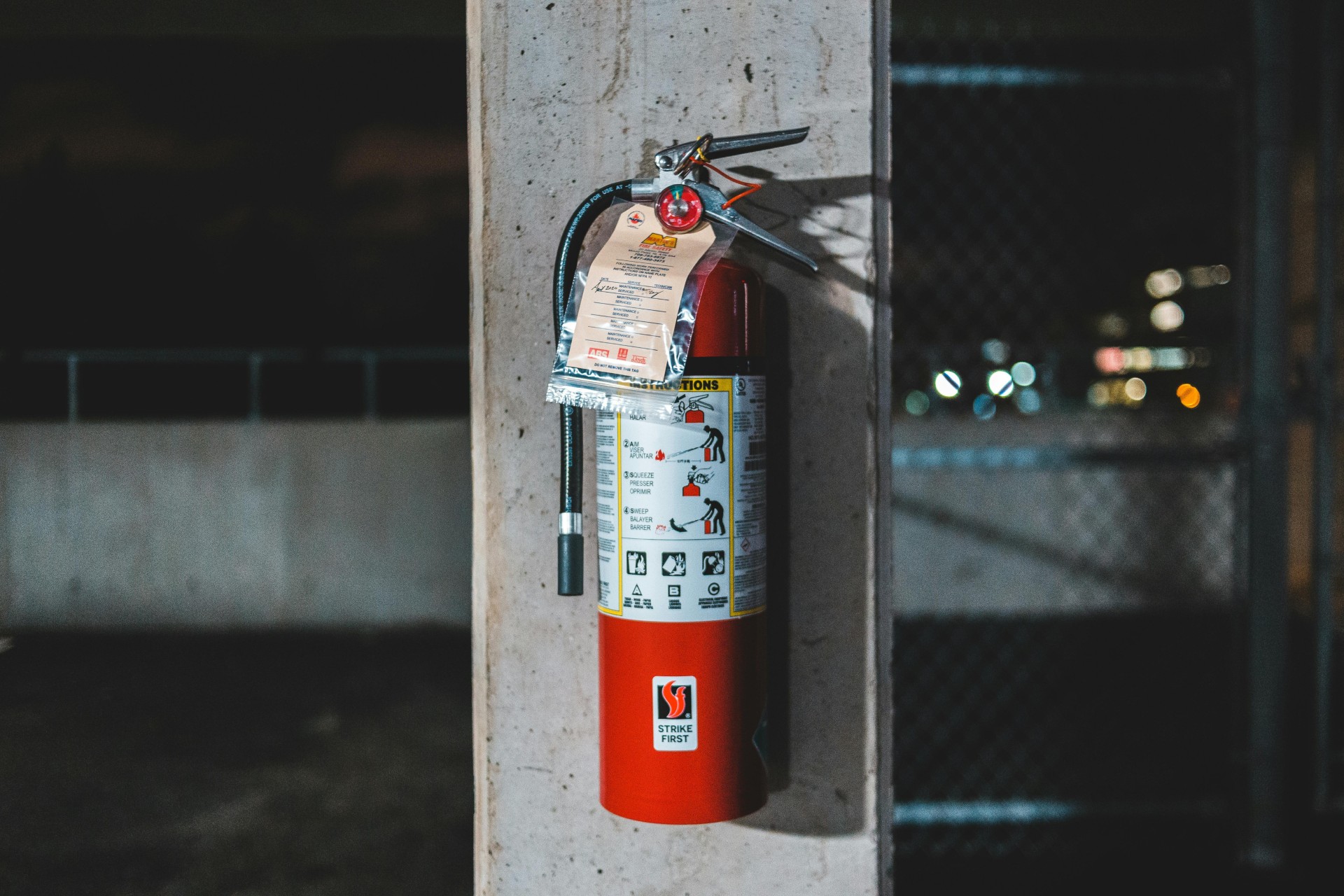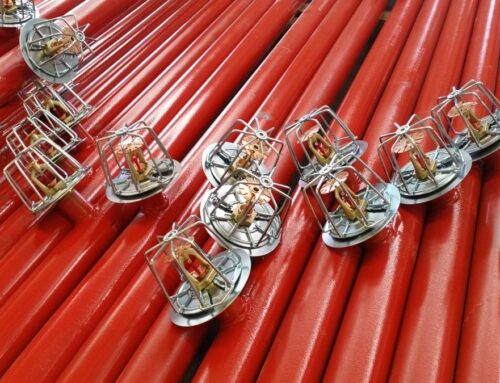Fire extinguishers play a crucial role in fire safety, but understanding their labels can be confusing if you don’t know what to look for. Whether you’re a business owner, homeowner, or responsible for fire safety compliance, knowing how fire extinguishers are labeled ensures you have the right protection for potential fire hazards.
In this guide, we’ll break down fire extinguisher labels, including classification letters, rating numbers, and manufacturer details.
Understanding Fire Extinguisher Classifications
Fire extinguishers are labeled based on the type of fire they are designed to combat. In the U.S., the National Fire Protection Association (NFPA) and the Occupational Safety and Health Administration (OSHA) define five primary classes:
- Class A – Fires involving ordinary combustibles like wood, paper, cloth, and plastics.
- Class B – Fires fueled by flammable liquids such as gasoline, oil, and grease.
- Class C – Electrical fires, including live wiring, appliances, and circuit breakers.
- Class D – Fires involving combustible metals like magnesium, titanium, and aluminum powder.
- Class K – Fires in commercial kitchens, typically involving grease, cooking oils, and animal fats.
Each fire extinguisher is labeled with these letters, making it easy to determine its intended use.
What Do the Numbers on Fire Extinguishers Mean?
In addition to the letter classifications, some fire extinguishers have numerical ratings. These ratings indicate the extinguisher’s effectiveness and capacity.
Class A Ratings
Measured in numbers like “1-A,” “2-A,” etc. Each number represents the equivalent effectiveness of 1.25 gallons of water. For example, a 4-A extinguisher is as effective as 5 gallons of water.
Class B Ratings
Represented as “10-B,” “20-B,” etc. The number indicates the approximate square footage the extinguisher can cover for flammable liquid fires. A 40-B extinguisher can cover 40 square feet of burning liquid.
Class C, D, and K Ratings
These classes do not have numerical ratings. Instead, a fire extinguisher labeled “C” means it is safe to use on electrical fires, while Class D and K extinguishers are designed specifically for metal and grease fires, respectively.
Fire Extinguisher Labeling Requirements
All fire extinguishers must have a manufacturer’s label that includes:
- Classification (A, B, C, D, K) – Indicates the type of fire it can extinguish.
- UL Rating (if applicable) – Displays the numerical effectiveness of the extinguisher.
- Instructions for Use – Step-by-step directions for operating the extinguisher.
- Maintenance and Inspection Requirements – Details about routine checks and servicing.
- Manufacturing Date and Expiration – Helps ensure the extinguisher is still functional.

Why Understanding Labels Matters
Having the wrong fire extinguisher for a fire type can be ineffective—or even dangerous. For example, using a water-based Class A extinguisher on an electrical fire (Class C) could cause electrocution. Likewise, a Class B extinguisher used on metal fires (Class D) may not extinguish the flames properly.
Choosing the Right Fire Extinguisher for Your Needs
Selecting the right fire extinguisher depends on several factors, including the type of fire hazards present, extinguisher size, workplace compliance requirements, and ease of use. Here’s a breakdown of key considerations:
1. Identify Fire Hazards in Your Home or Business
Different environments require different types of fire extinguishers:
- Homes: A multi-purpose ABC extinguisher is ideal for most homes since it can handle ordinary combustibles, flammable liquids, and electrical fires.
- Commercial Kitchens: A Class K extinguisher is essential for restaurants and food service establishments due to grease and cooking oil fires.
- Workshops & Industrial Settings: Facilities dealing with combustible metals should have a Class D extinguisher, which is designed for metal fires that water or standard extinguishers can’t handle.
- Offices & Server Rooms: Class C extinguishers are needed in areas with a high concentration of electrical equipment to prevent electrical fires.
2. Choose the Right Fire Extinguisher Size
Fire extinguishers come in different sizes, each with varying amounts of extinguishing agent.
- 2.5 lb. Extinguisher – Small, portable, and ideal for personal vehicles, small kitchens, or home offices.
- 5 lb. Extinguisher – A good mid-range option for homes, small businesses, and general office use.
- 10 lb. Extinguisher – Recommended for commercial settings, garages, or larger workplaces where a bigger fire might need suppression.
- 20 lb. Extinguisher – Ideal for warehouses, industrial sites, or large commercial buildings where fires can spread quickly.
3. Consider the Extinguisher’s Discharge Time & Range
- Smaller extinguishers (2.5–5 lb.) generally last 8–10 seconds with a range of 6–8 feet.
- Larger extinguishers (10–20 lb.) can last 15–25 seconds and have a range of 10–20 feet.
- A longer discharge time and range may be crucial in industrial or commercial settings where fire hazards are more significant.
4. Ensure Compliance with Local Fire Safety Codes
If you are a business owner, you need to follow fire safety regulations:
- OSHA (Occupational Safety and Health Administration) requires businesses to have properly labeled, mounted, and accessible fire extinguishers.
- NFPA (National Fire Protection Association) 10 sets specific guidelines on fire extinguisher selection, maintenance, and placement.
- Missouri Fire Codes may have additional local regulations regarding extinguisher requirements in commercial and industrial settings.
5. Consider Special Environments & Climate Conditions
- Cold Weather Areas: If storing an extinguisher in an unheated area (garage, outdoor shed, construction site), choose one rated for low temperatures to prevent freezing.
- Marine Use: Fire extinguishers on boats must be Coast Guard-approved and rated for marine use, typically using Class B & C ratings.
- Chemical or Sensitive Areas: Places like laboratories or data centers may require clean agent extinguishers (e.g., CO2 or Halotron) to avoid damaging sensitive electronics.
6. Proper Placement and Accessibility
- Fire extinguishers should be easily accessible and mounted in visible locations.
- Keep extinguishers near fire-prone areas such as kitchens, garages, and electrical panels.
- In commercial buildings, OSHA requires fire extinguishers to be spaced no more than 75 feet apart for quick access.
7. Training and Maintenance
- Having the right extinguisher is only useful if employees and residents know how to use it. Conduct fire safety training and teach proper extinguisher use (PASS method: Pull, Aim, Squeeze, Sweep).
- Regular inspections and maintenance ensure extinguishers remain functional. Check pressure gauges monthly and have professional servicing done annually.
Our Final Thoughts
Fire extinguishers are labeled to ensure users can quickly and effectively respond to fires. By understanding these labels—including classification letters, numerical ratings, and safety instructions—you can choose and maintain the right extinguisher for your needs.
For professional fire protection services in Missouri, including fire extinguisher inspection, installation, and compliance assistance, contact Ideal Fire Services.

